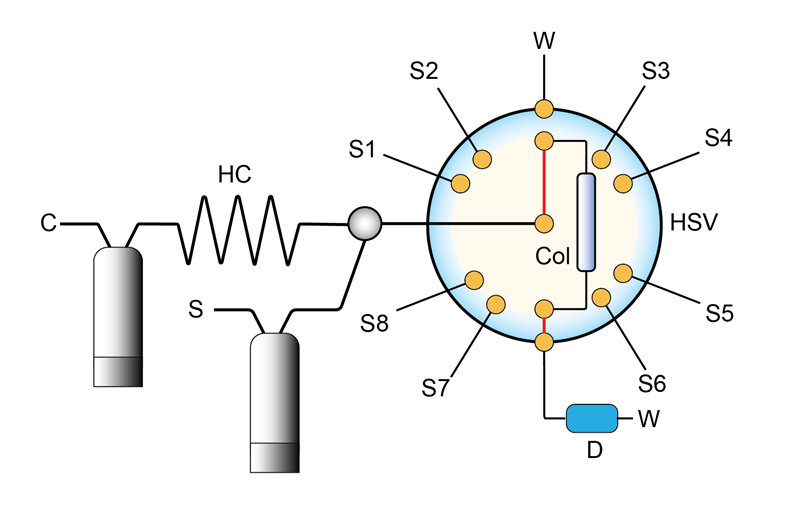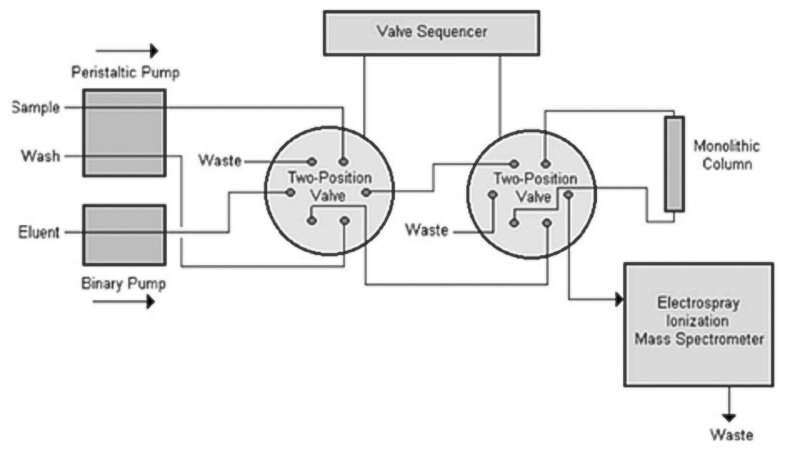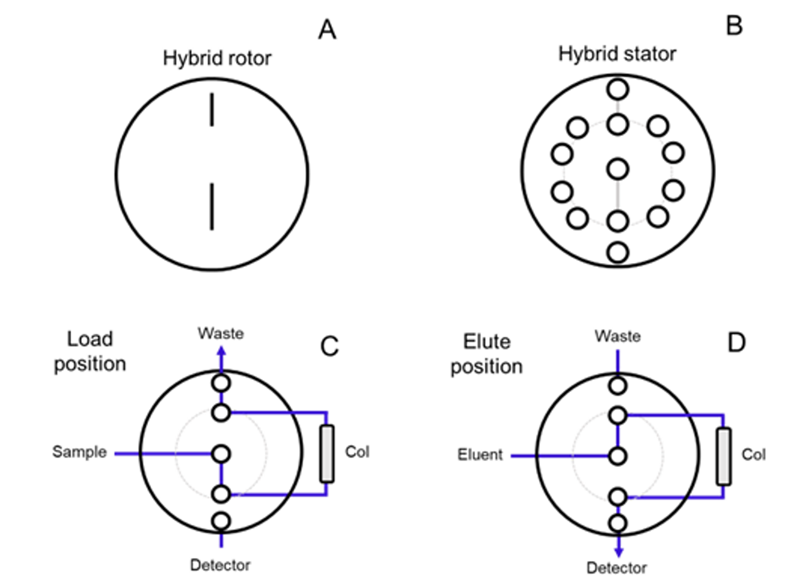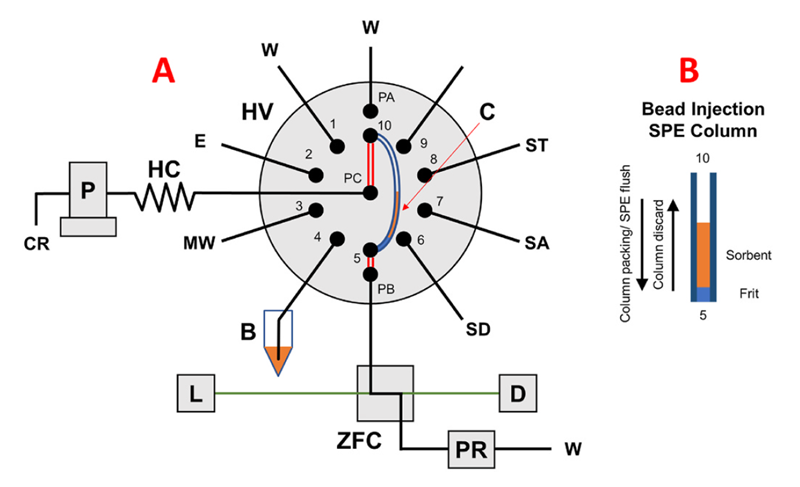Hybrid rotor-stator selection valve for efficient SPE in SIA and pFI
 PHOTO: Tim descending the Emmons Glacier on Mount Rainier, Washington, USA.
PHOTO: Tim descending the Emmons Glacier on Mount Rainier, Washington, USA.
Timothy Trinklein (Google Scholar profile) is currently a postdoctoral associate at the University of Illinois at Urbana Champaign. He received his B.S. in Chemistry in 2018 at the University of Wisconsin Milwaukee, where he hyphenated flow injection instrumentation with bench-top NMR spectroscopy. He then moved to Seattle, WA to pursue a PhD in analytical chemistry with Rob Synovec, where his research focused on instrumentation and chemometrics for comprehensive two-dimensional gas chromatography / mass spectrometry (GC×GC-MS). In Seattle, Tim developed a passion for mountaineering and alpine climbing. After graduating in 2023, Tim moved to the flatlands of Champaign, Illinois to work in the lab of Jonathan Sweedler, where he is developing MALDI mass spectrometry methods for biomolecular imaging and high-throughput analysis of single cells in neurodegenerative disease models. Tim has a broad interest in analytical techniques ranging from flow analysis and capillary separations to mass spectrometry and their application to pressing problems in environmental science and biology. Tim is a strong believer that as analytical chemists, we must match the correct tool for the problem at hand, and that as educators, we must continue to foster builders instead of users in order to maintain analytical science as the exciting and challenging field it is.
Hybrid rotor-stator selection valve for efficient SPE in SIA and pFI
Sample preconcentration and matrix removal by online solid phase extraction (SPE) is easily automated using pFI/SIA, enabling sample preconcentration with the removal of matrix interferences. New innovations in flow analysis technology have now overcome many of the disadvantages in early cFI systems.
In order to provide optimum efficacy, an ideal automated pFI/SIA-SPE system should have the following two characteristics;
- The ability to load large volumes of sample onto the SPE column. This is accomplished by pFI and SIA systems containing two pumps, one of which is directly connected to a large sample reservoir.
- The ability to load and elute the sample in the opposite direction from the SPE column. This prevents the column from becoming continuously more tightly packed and provides sharp elution bands (Fang, 1993).
The use of an instrument with two milliGAT pumps, as provided by commercial GlobalFIA instruments (e.g., Mini SIA-2 and FloPro-SPE), enables large volume sample loading. The first pump, which draws carrier solution, is connected to the holding coil, then connected via a T-junction to the selection valve. The second pump can be directly connected to a large sample reservoir such that sample can be continuously loaded onto the column. Here, the only restrictions upon sample volume are the size of the reservoir and the breakthrough volume of the column. This instrumental design overcomes the barrier in early SIA instruments where the maximum volume to be loaded onto the column was that of the holding coil.
 Fig. 1. A pFI/SIA system designed to enable large-volume sample loading. C: carrier, S: sample/standard, HC: holding coil, HSV: hybrid selection valve, Col: column, D: detector, W: waste.
Fig. 1. A pFI/SIA system designed to enable large-volume sample loading. C: carrier, S: sample/standard, HC: holding coil, HSV: hybrid selection valve, Col: column, D: detector, W: waste.
Modern “mini-columns” made for pFI/SIA systems are about 1-2 cm in length and are often designed in a conical shape. With these columns, the sample is introduced into the tapered, narrower end and eluted in the reverse direction through the same end. Increased peak heights due to reduced dispersion were observed using conical columns were known in the very early days of FI-SPE (Fang, 1989). Today, mini-columns are commercially available from GlobalFIA and are straightforward to pack by the analyst. For instance, sorbent from traditional SPE cartridges can be dispersed into a slurry and loaded into the mini-column with a syringe.
In early cFI systems, the ability to load and elute sample in opposite directions required complicated FIA manifolds, with two valves operated in sequence (Fig 2).
 Fig 2. A cFI manifold for SPE with sample loading and elution in opposite directions. Note also that the use of multiple lines in the peristalic pump can be used for large sample loading, albeit with the disadvantages of peristaltic pump (Ammerman, 2009).
Fig 2. A cFI manifold for SPE with sample loading and elution in opposite directions. Note also that the use of multiple lines in the peristalic pump can be used for large sample loading, albeit with the disadvantages of peristaltic pump (Ammerman, 2009).
With the advent of pFI and SIA systems produced by GlobalFIA, much simpler designs are now possible. Critical is the invention of a hybrid rotor-stator valve by GlobalFIA (Fig. 3), which enables columns to be loaded and eluted in opposite directions using the sample selection valve for standard pFI and SIA manipulations.
 Fig 3. Hybrid rotor-stator selection valve for online SPE (Trinklein, 2021).
Fig 3. Hybrid rotor-stator selection valve for online SPE (Trinklein, 2021).
This valve is incorporated in the commercial FloPro-SPE instrument available from Global FIA.
The combination of large-volume sample loading and flow reversal upon elution enabled the first hyphenation of pFI/SIA to NMR. Due to the inherently poor detection limits of NMR, especially low-field, benchtop NMR spectrometers, sample preconcentraiton is often necessary. Using the FloPro-SPE with a custom high-capacity column, low levels of drugs in seized forensic samples could be preconcentrated and purified from interferents before NMR detection (Trinklein 2021).
The hybrid valve also enables efficient bead injection (BI) assays. In this configuration (Fig. 3), beads can be loaded into a “column” made from tubing on between ports 5 and 10 of a 10 port selection valve, and then dispensed to waste upon flow reversal. In the first demonstration of this mode of operation, a fast and efficient BI assay was developed for the detection of creatine in urine (Chocholouš, 2023).
 Fig 4. Instrument design with hybrid-valve used for automation of bead injection. (Chocholouš, 2023).
Fig 4. Instrument design with hybrid-valve used for automation of bead injection. (Chocholouš, 2023).
References
[1] Fang, Z. Flow Injection Separation and Preconcentration; VCH, 1993.
[2] Fang, Z.; Welz, B. High efficiency low sample consumption on-line ion-exchange pre-concentration system for flow injection flame atomic absorption spectrometry. Journal of Analytical Atomic Spectrometry 1989, 4 (6), 543-546, https://doi.org/10.1039/JA9890400543.
[3] Ammerman, J. L.; Aldstadt, J. H. Monolithic solid-phase extraction for the rapid on-line monitoring of microcystins in surface waters. Microchimica Acta 2009, 164 (1), 185-196. DOI: 10.1007/s00604-008-0056-8.
[4] Trinklein, T. J.; Thapa, M.; Lanphere, L. A.; Frost, J. A.; Koresch, S. M.; Aldstadt, J. H. Sequential injection analysis coupled to on-line benchtop proton NMR: Method development and application to the determination of synthetic cathinones in seized drug samples. Talanta 2021, 231, 122355. DOI: https://doi.org/10.1016/j.talanta.2021.122355.
[5] Chocholouš, P.; Vinklárek, J.; Semerádová, E.; Miekh, Y.; Marshall, G. D.; Solich, P. Innovated single flush on-line solid-phase extraction in bead injection format for flow programming-based determination of creatinine in human urine. Talanta 2023, 258, 124420. DOI: https://doi.org/10.1016/j.talanta.2023.124420.